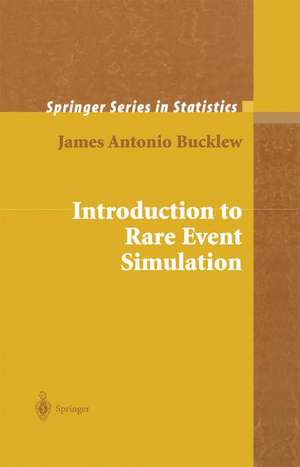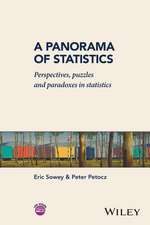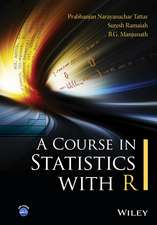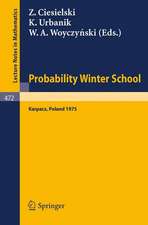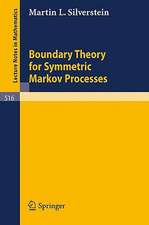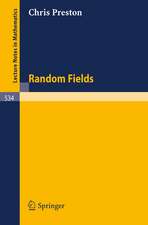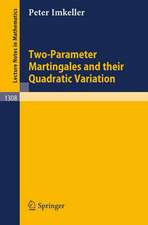Introduction to Rare Event Simulation: Springer Series in Statistics
Autor James Bucklewen Limba Engleză Hardback – 11 mar 2004
| Toate formatele și edițiile | Preț | Express |
|---|---|---|
| Paperback (1) | 725.75 lei 6-8 săpt. | |
| Springer – 29 noi 2010 | 725.75 lei 6-8 săpt. | |
| Hardback (1) | 783.98 lei 6-8 săpt. | |
| Springer – 11 mar 2004 | 783.98 lei 6-8 săpt. |
Din seria Springer Series in Statistics
- 14%
 Preț: 679.60 lei
Preț: 679.60 lei - 20%
 Preț: 630.97 lei
Preț: 630.97 lei - 20%
 Preț: 816.43 lei
Preț: 816.43 lei - 20%
 Preț: 1000.84 lei
Preț: 1000.84 lei -
 Preț: 390.84 lei
Preț: 390.84 lei - 20%
 Preț: 697.13 lei
Preț: 697.13 lei - 20%
 Preț: 445.20 lei
Preț: 445.20 lei - 20%
 Preț: 881.51 lei
Preț: 881.51 lei - 18%
 Preț: 1237.14 lei
Preț: 1237.14 lei - 18%
 Preț: 967.22 lei
Preț: 967.22 lei - 18%
 Preț: 956.50 lei
Preț: 956.50 lei - 18%
 Preț: 794.25 lei
Preț: 794.25 lei - 15%
 Preț: 648.05 lei
Preț: 648.05 lei - 18%
 Preț: 1222.49 lei
Preț: 1222.49 lei - 15%
 Preț: 646.11 lei
Preț: 646.11 lei - 15%
 Preț: 647.08 lei
Preț: 647.08 lei - 15%
 Preț: 646.11 lei
Preț: 646.11 lei - 18%
 Preț: 1389.62 lei
Preț: 1389.62 lei - 15%
 Preț: 652.81 lei
Preț: 652.81 lei - 18%
 Preț: 1114.52 lei
Preț: 1114.52 lei - 18%
 Preț: 952.40 lei
Preț: 952.40 lei - 18%
 Preț: 1393.27 lei
Preț: 1393.27 lei - 18%
 Preț: 1561.68 lei
Preț: 1561.68 lei - 18%
 Preț: 1231.47 lei
Preț: 1231.47 lei - 15%
 Preț: 513.64 lei
Preț: 513.64 lei - 18%
 Preț: 893.71 lei
Preț: 893.71 lei - 15%
 Preț: 649.87 lei
Preț: 649.87 lei - 18%
 Preț: 1007.65 lei
Preț: 1007.65 lei - 18%
 Preț: 1111.67 lei
Preț: 1111.67 lei - 18%
 Preț: 1229.10 lei
Preț: 1229.10 lei - 18%
 Preț: 892.74 lei
Preț: 892.74 lei - 18%
 Preț: 913.26 lei
Preț: 913.26 lei - 18%
 Preț: 943.88 lei
Preț: 943.88 lei -
 Preț: 391.61 lei
Preț: 391.61 lei -
 Preț: 391.22 lei
Preț: 391.22 lei - 18%
 Preț: 1391.04 lei
Preț: 1391.04 lei -
 Preț: 390.84 lei
Preț: 390.84 lei - 18%
 Preț: 893.84 lei
Preț: 893.84 lei - 18%
 Preț: 960.61 lei
Preț: 960.61 lei - 18%
 Preț: 1245.34 lei
Preț: 1245.34 lei - 18%
 Preț: 964.54 lei
Preț: 964.54 lei - 15%
 Preț: 643.16 lei
Preț: 643.16 lei - 18%
 Preț: 1674.70 lei
Preț: 1674.70 lei - 15%
 Preț: 643.84 lei
Preț: 643.84 lei - 15%
 Preț: 586.37 lei
Preț: 586.37 lei - 18%
 Preț: 1004.99 lei
Preț: 1004.99 lei - 15%
 Preț: 643.34 lei
Preț: 643.34 lei - 18%
 Preț: 806.40 lei
Preț: 806.40 lei - 18%
 Preț: 727.66 lei
Preț: 727.66 lei
Preț: 783.98 lei
Preț vechi: 956.08 lei
-18% Nou
Puncte Express: 1176
Preț estimativ în valută:
150.03€ • 154.99$ • 124.87£
150.03€ • 154.99$ • 124.87£
Carte tipărită la comandă
Livrare economică 26 martie-09 aprilie
Preluare comenzi: 021 569.72.76
Specificații
ISBN-13: 9780387200781
ISBN-10: 0387200789
Pagini: 260
Ilustrații: XII, 268 p.
Dimensiuni: 155 x 235 x 15 mm
Greutate: 0.5 kg
Ediția:2004
Editura: Springer
Colecția Springer
Seria Springer Series in Statistics
Locul publicării:New York, NY, United States
ISBN-10: 0387200789
Pagini: 260
Ilustrații: XII, 268 p.
Dimensiuni: 155 x 235 x 15 mm
Greutate: 0.5 kg
Ediția:2004
Editura: Springer
Colecția Springer
Seria Springer Series in Statistics
Locul publicării:New York, NY, United States
Public țintă
ResearchCuprins
1. Random Number Generation.- 2. Stochastic Models.- 3. Large Deviation Theory.- 4. Importance Sampling.- 5. The Large Deviation Theory of Importance Sampling Estimators.- 6. Variance Rate Theory of Conditional Importance Sampling Estimators.- 7. The Large Deviations of Bias Point Selection.- 8. Chernoff’s Bound and Asymptotic Expansions.- 9. Gaussian Systems.- 10. Universal Simulation Distributions.- 11. Rare Event Simulation for Level Crossing and Queueing Models.- 12. Blind Simulation.- 13. The (Over-Under) Biasing Problem in Importance Sampling.- 14. Tools and Techniques for Importance Sampling.- A. Convex Functions and Analysis.- B. A Covering Lemma.- C. Pseudo-Random Number Generator Programs.- References.
Recenzii
From the reviews:
"On the whole, Introduction to Rare Event Simulation succeeds at its stated goal, providing a good overview of importance sampling from the perspective of large deviations." Journal of the American Statistical Association, September 2005
"The main purpose of this book is to present a unified theory of rare event simulation and the variance reduction technique known as importance sampling method devised from the point of view of probabilistic theory of large deviations. … The methodology of importance sampling estimation based on large deviation theory is exposed in a clear setting, concentrating on the main ideas and outlining the variety of applications, from telecommunications to queueing systems." (Silvia Curteanu, Zentralblatt MATH, Vol. 1057(8), 2005)
"This book deals with a special topic in simulation, the estimation of small probabilities via importance sampling using large deviations theory to design and/or analyze the change of measure. … serve as a bridge to the quite technical research literature and a help to get started with more challenging examples." (S. Asmussen, Short Book Reviews, Vol. 24(2), 2004)
"The principal method described in this book used to attack the rare event simulation problem is importance sampling, which is a variance reduction technique. … This Introduction to Rare Event Simulation is in the first place not a book on the theory of rare events as developed in extreme value theory via point processes … . Instead, it focuses on the mathematics of importance sampling estimators. As such it is mathematically rigorous and very enjoyable." (Michael Falk, Metrika, 2006)
"The central theme of the book is to compute the probability of a so-called rare event. … Overall the book is pleasant to read. … The book seems to be well suited to use as a text for a course. … My general impression of the book is … predominantly positive and I woulddefinitely recommend this book to be used as course material or as an easily accessible introduction to rare event simulation for anyone with a general knowledge of probability theory." (Henrik Hult, Extremes, Vol. 7, 2004)
"This is a very interesting monograph that attempts to present a unified theory of rare events simulation. Two basic tools used are importance sampling and the theory of large deviations. … I recommend the book to everybody who is interested in rare events and/or Monte Carlo simulation." (EMS Newsletter, December 2006)
"On the whole, Introduction to Rare Event Simulation succeeds at its stated goal, providing a good overview of importance sampling from the perspective of large deviations." Journal of the American Statistical Association, September 2005
"The main purpose of this book is to present a unified theory of rare event simulation and the variance reduction technique known as importance sampling method devised from the point of view of probabilistic theory of large deviations. … The methodology of importance sampling estimation based on large deviation theory is exposed in a clear setting, concentrating on the main ideas and outlining the variety of applications, from telecommunications to queueing systems." (Silvia Curteanu, Zentralblatt MATH, Vol. 1057(8), 2005)
"This book deals with a special topic in simulation, the estimation of small probabilities via importance sampling using large deviations theory to design and/or analyze the change of measure. … serve as a bridge to the quite technical research literature and a help to get started with more challenging examples." (S. Asmussen, Short Book Reviews, Vol. 24(2), 2004)
"The principal method described in this book used to attack the rare event simulation problem is importance sampling, which is a variance reduction technique. … This Introduction to Rare Event Simulation is in the first place not a book on the theory of rare events as developed in extreme value theory via point processes … . Instead, it focuses on the mathematics of importance sampling estimators. As such it is mathematically rigorous and very enjoyable." (Michael Falk, Metrika, 2006)
"The central theme of the book is to compute the probability of a so-called rare event. … Overall the book is pleasant to read. … The book seems to be well suited to use as a text for a course. … My general impression of the book is … predominantly positive and I woulddefinitely recommend this book to be used as course material or as an easily accessible introduction to rare event simulation for anyone with a general knowledge of probability theory." (Henrik Hult, Extremes, Vol. 7, 2004)
"This is a very interesting monograph that attempts to present a unified theory of rare events simulation. Two basic tools used are importance sampling and the theory of large deviations. … I recommend the book to everybody who is interested in rare events and/or Monte Carlo simulation." (EMS Newsletter, December 2006)
Textul de pe ultima copertă
This book presents a unified theory of rare event simulation and the variance reduction technique known as importance sampling from the point of view of the probabilistic theory of large deviations. This perspective allows us to view a vast assortment of simulation problems from a unified single perspective. It gives a great deal of insight into the fundamental nature of rare event simulation.
Until now, this area has a reputation among simulation practitioners of requiring a great deal of technical and probabilistic expertise. This text keeps the mathematical preliminaries to a minimum with the only prerequisite being a single large deviation theory result that is given and proved in the text. Large deviation theory is a burgeoning area of probability theory and many of the results in it can be applied to simulation problems. Rather than try to be as complete as possible in the exposition of all possible aspects of the available theory, the book concentrates on demonstrating the methodology and the principal ideas in a fairly simple setting.
The book contains over 50 figures and detailed simulation case studies covering a wide variety of application areas including statistics, telecommunications, and queueing systems.
James A. Bucklew holds the rank of Professor with appointments in the Department of Electrical and Computer Engineering and in the Department of Mathematics at the University of Wisconsin-Madison. He is a Fellow of the Institute of Electrical and Electronics Engineers and the author of Large Deviation Techniques in Decision, Simulation, and Estimation.
Until now, this area has a reputation among simulation practitioners of requiring a great deal of technical and probabilistic expertise. This text keeps the mathematical preliminaries to a minimum with the only prerequisite being a single large deviation theory result that is given and proved in the text. Large deviation theory is a burgeoning area of probability theory and many of the results in it can be applied to simulation problems. Rather than try to be as complete as possible in the exposition of all possible aspects of the available theory, the book concentrates on demonstrating the methodology and the principal ideas in a fairly simple setting.
The book contains over 50 figures and detailed simulation case studies covering a wide variety of application areas including statistics, telecommunications, and queueing systems.
James A. Bucklew holds the rank of Professor with appointments in the Department of Electrical and Computer Engineering and in the Department of Mathematics at the University of Wisconsin-Madison. He is a Fellow of the Institute of Electrical and Electronics Engineers and the author of Large Deviation Techniques in Decision, Simulation, and Estimation.
Caracteristici
Presents a unified theory of rare event simulation and the variance reduction technique known as importance sampling from the point of view of the probabilistic theory of large deviations Allows us to view a vast assortment of simulation problems from a unified single perspective Includes supplementary material: sn.pub/extras
